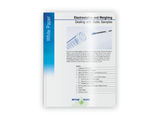To use all functions of this page, please activate cookies in your browser.
my.bionity.com
With an accout for my.bionity.com you can always see everything at a glance – and you can configure your own website and individual newsletter.
- My watch list
- My saved searches
- My saved topics
- My newsletter
Operon
An operon is a functioning unit of key nucleotide sequences including an operator, a common promoter, and one or more structural genes, which are controlled as a unit to produce messenger RNA (mRNA), in the process of protein transcription.
Additional recommended knowledge
OverviewOperons occur primarily in prokaryotes and nematodes. Although it may be not be located in the operon gene, a "Regulator" gene is present which codes for the production of a repressor or corepressor protein. The location and condition of the regulator, promoter, operator and structural DNA sequences can determine the effects of common mutations. The first operon to be described was the lac-operon in Escherichia coli, by F. Jacob, D. Perrin, C. Sanchez and J. Monod in the "Comptes rendus hebdomadaires des séances de l'Académie des sciences" in 1960[2]. Operons are related to regulons and stimulons. Whereas operons contain a set of genes regulated by the same operator, regulons contain a set of genes under regulation by a single regulatory protein, and stimulons contain a set of genes under regulation by a single cell stimulus. The operon as a unit of transcriptionAn operon contains one or more structural genes which are transcribed into one polycistronic mRNA: a single mRNA molecule that codes for more than one protein. Upstream of the structural genes lies a promoter sequence which provides a site for RNA polymerase to bind and initiate transcription. Close to the promoter lies a section of DNA called an operator. The operon may also contain regulatory genes such as a repressor gene which codes for a regulatory protein that binds to the operator and inhibits transcription. Regulatory genes need not be part of the operon itself, but may be located elsewhere in the genome. The repressor molecule will reach the operator to block the transcription of the structural genes. Promoter
A promoter is a DNA sequence that enables a gene to be transcribed. The promoter is recognized by RNA polymerase, which then initiates transcription. In RNA synthesis, promoters indicate which genes should be used for messenger RNA creation - and, by extension, control which proteins the cell manufactures. OperatorAn operator is a segment of DNA which regulates the activity of the structural genes of the operon that it is linked to, by interacting with a specific repressor or activator. It is a regulatory sequence for shutting a gene down or turning it "on". Operon gene regulationControl of operon genes is a type of gene regulation that enables organisms to regulate the expression of various genes depending on environmental conditions. Operon regulation can be either negative or positive. Negative regulation involves the binding of a repressor to the operator to prevent transcription.
Operons can also be positively controlled. With positive control, an activator protein stimulates transcription by binding to DNA (usually at a site other than the operator).
The lac operon
The lac operon of the model bacterium Escherichia coli was the first operon to be discovered and provides a typical example of operon function. It consists of three adjacent structural genes, a promoter, a terminator, and an operator. The lac operon is regulated by several factors including the availability of glucose and lactose. Trp operon
Discovered in 1953 by Jacques Monod and colleagues, the trp operon in E. coli was the first repressible operon to be discovered. While the lac operon can be activated by a chemical (lactose), the tryptophan (Trp) operon is inhibited by a chemical (tryptophan). This operon contains five structural genes: trp E, trp D, trp C, trp B, and trp A, which encodes tryptophan synthetase. It also contains a promoter which binds to RNA polymerase and an operator which blocks transcription when bound to the protein synthesized by the repressor gene (trp R) that binds to the operator. In the lac operon, lactose binds to the repressor protein and prevents it from repressing gene transcription, while in the trp operon, tryptophan binds to the repressor protein and enables it to repress gene transcription. Also different between the trp operon and the lac operon, the trp operon contains a leader peptide and an attenuator sequence which allows for graded regulation.[1] Predicting the number and organization of operonsThe number and organization of operons has been studied most critically in E. coli. As a result, predictions can be made based on an organism's genomic sequence. One prediction method uses the intergenic distance between reading frames as a primary predictor of the number of operons in the genome. The separation merely changes the frame and guarantees that the read through is efficient. Longer stretches exist where operons start and stop, often up to 40-50 bases [2]. Operon prediction is even more accurate if the functional class of the molecules is considered. Bacteria have clustered their reading frames into units, sequestered by co-involvement in protein complexes, common pathways, or shared substrates and transporters. Thus, accurate prediction would involve all of these data, a difficult task indeed. See alsoReferences
|
|||||||
| This article is licensed under the GNU Free Documentation License. It uses material from the Wikipedia article "Operon". A list of authors is available in Wikipedia. |







